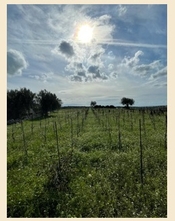 At last, we’re back to the Garden Isle of the Mediterranean after a brief foray into bubbles to put a nice bow on 2021. As we were discussing, Sicilia DOC is a relatively new appellation with a focus on Nero D’Avola and Grillo and their propensity to maintain varietal characteristics while at the same time expressing subregional terroir, all the while providing great value. Our tour took us to two small producers that give a good view into what’s going on with the DOC and what the future might hold, and there were several other producers that we got to taste. Let’s get started.
At last, we’re back to the Garden Isle of the Mediterranean after a brief foray into bubbles to put a nice bow on 2021. As we were discussing, Sicilia DOC is a relatively new appellation with a focus on Nero D’Avola and Grillo and their propensity to maintain varietal characteristics while at the same time expressing subregional terroir, all the while providing great value. Our tour took us to two small producers that give a good view into what’s going on with the DOC and what the future might hold, and there were several other producers that we got to taste. Let’s get started. 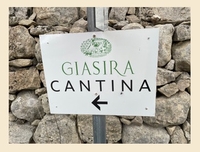 Giasara Winery is a 130 hectare family owned estate located in the hills near the city of Noto in the southeast, just shy of an hour south of Siracusa. The estate is situated between two canyons, producing a sort of “island” effect, where cooling breezes blow, increasing the diurnal temperature range which helps preserve acidity in grapes. Grillo, Nero D’Avola, Catarratto, Zibibbo, Nerello Mascalese and small amounts of Merlot and Chardonnay are grown amongst beautiful ancient olive and carob trees. Their Nero D’Avola was the first eye opener for me as to the stylistic shift that the DOC is shooting for:
Giasara Winery is a 130 hectare family owned estate located in the hills near the city of Noto in the southeast, just shy of an hour south of Siracusa. The estate is situated between two canyons, producing a sort of “island” effect, where cooling breezes blow, increasing the diurnal temperature range which helps preserve acidity in grapes. Grillo, Nero D’Avola, Catarratto, Zibibbo, Nerello Mascalese and small amounts of Merlot and Chardonnay are grown amongst beautiful ancient olive and carob trees. Their Nero D’Avola was the first eye opener for me as to the stylistic shift that the DOC is shooting for:
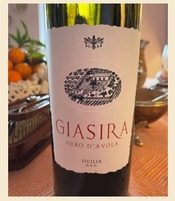 Giasira (Sicilia DOC) Nero D’Avola Organic 2018 ($18): This wine demonstrates a new page in this variety’s story, one where the inky, super ripe wines of yesteryear are beginning to give way to more elegant, acid driven wines that you can read the newspaper through. Black cherry, a little tar, pepper, orange zest and easy spice present in a more Grenache-like style, and they finish long with good integration. It stood up to a Penne alla Norma’s zesty tomato sauce with no trouble at all. 91
Giasira (Sicilia DOC) Nero D’Avola Organic 2018 ($18): This wine demonstrates a new page in this variety’s story, one where the inky, super ripe wines of yesteryear are beginning to give way to more elegant, acid driven wines that you can read the newspaper through. Black cherry, a little tar, pepper, orange zest and easy spice present in a more Grenache-like style, and they finish long with good integration. It stood up to a Penne alla Norma’s zesty tomato sauce with no trouble at all. 91
The Grillo from Giasira acquits itself in similar fashion, with the micro-climate “island” zesting things up:
Giasira (Sicilia DOC) Grillo Organic 2020 ($17): This all-stainless steel offering spent six months on the lees and three months in bottle prior to release. Flower and white melon aromas lead to a palate where the melon is joined by lemon and stony minerality, and they all ride crisp acidity through a medium weight palate that finishes long with a citrus kiss on the end. I imagine a lot of this will be consumed with seafood tapas as the Sicilian spring turns to summer. 90
Outside the DOC rules, Giasira also produces an excellent sparkling Rosato called “Sic!” made from Nerello Mascalese that’s worth seeking out:
Giasira (Terre Siciliane Rosato IGT) Brut Rosato, Metodo Classico "Sic!" ($20): It seems the four corners of the earth are rising to the sparkling wine demand of late, some more successfully than others. This is a delightful, pale salmon colored Rosato, presenting an elegant fine mousse that carries strawberry and citrus flavors with a dash of herbal character that adds depth. I’m intrigued of late with sparklers that go beyond the box of Chardonnay and Pinot Noir, and "Sic!" certainly delivers pleasure. 91
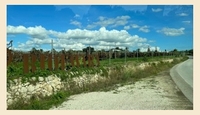 Our second visit found us at Massimo Padova’s Riofavara estate, a meticulously kept set of vineyards just southeast of Noto and close to the town of Avola. A walk through one of the vineyards presented a spring like atmosphere, with a fresh green cover crop with tiny wildflowers that was teeming with insect life. He presented 4 different expressions of Nero D’Avola, each offering a different profile, yet clearly showing a common thread:
Our second visit found us at Massimo Padova’s Riofavara estate, a meticulously kept set of vineyards just southeast of Noto and close to the town of Avola. A walk through one of the vineyards presented a spring like atmosphere, with a fresh green cover crop with tiny wildflowers that was teeming with insect life. He presented 4 different expressions of Nero D’Avola, each offering a different profile, yet clearly showing a common thread:
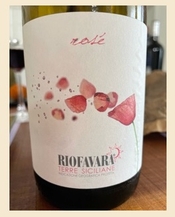 Riofavara (Terre Siciliane IGP) Rosé of Nero D’Avola 2020: Nero D’Avola is very difficult when it comes to Rosé due to its black skin and red pulp, but a fairly early harvest helps mitigate color issues, and selecting fruit from parcels with different exposures gives a palette to work with. This vintage shows tart cherry, lemon and bay leaf aromas and flavors, zesty acidity and a touch of grip extends the mouth-watering finish. Unique! 91
Riofavara (Terre Siciliane IGP) Rosé of Nero D’Avola 2020: Nero D’Avola is very difficult when it comes to Rosé due to its black skin and red pulp, but a fairly early harvest helps mitigate color issues, and selecting fruit from parcels with different exposures gives a palette to work with. This vintage shows tart cherry, lemon and bay leaf aromas and flavors, zesty acidity and a touch of grip extends the mouth-watering finish. Unique! 91
Riofavara (Sicilia DOC) “San Basilio” Nero D’Avola 2019: This bottling is all about varietal character and regionality, with 100% stainless steel fermentation and aging. It’s very expressive, showing bright mixed berry fruit, violets, tar and pepper, with moderate tannins and full integration of flavors. Even though there’s no oak here, I get an oak like structure thanks to the thick skins and minimal handling. 92
Riofavara (Eloro DOC Sicilia) “Spaccaforno” Nero D’Avola 2019: This wine spent two years in second-use large format oak, which imparts a dash of vanilla, a soft toasty note and midpalate texture to the mix of berries and gentle pepper. This was just released at tasting, and showed a reductive note that will easily fold in with a little bottle aging. 91
Riofavara (Eloro DOC Sicilia) “Sciave” Nero D’Avola 2017: Bottled in 2021, this 100% Nero D’Avola spent 18 months in 500 liter tonneau for rounding of the edges rather than imparting over character. The resulting wine shows up to the edge ripeness with notes of blueberry pie and meat. These are not words that usually accompany numbers like TA 7.8 g/l, pH 3.38 and ABV 13.5%. The discussion at the table led us to calling this a wine with an American nose and a Sicilian soul. It’ll age beautifully. 96
Riofavara (Sicilia DOC) White Blend “Nsajar” 2020: “Nsajar” means “to try”, and this wine is a long term experiment. Riofavara owner Massimo Padova is one of a small but growing group of Sicilian vintners who are looking to revive some of the island’s forgotten varieties, some of which until very recently had only one or two surviving vines on the entire island. A little reticent to name the specific grapes in this blend, Massimo intimated that the micro-vinifications of the individual varieties were not terribly interesting at this stage in their development, but that the blend “orchestra” works very well. I would agree, with my glass showing soft pear, lime, lime zest and limestone minerality in both aroma and flavor and lively acidity that keeps the flavors coming. It’s a real refresher, and the next vintage is slated to carry the Sicilia DOC designation. 92
These two properties show the range possible with the regional stars and also show an eye “backward/forward” where historically cultivated grapes are allowed another day in the sun.
I’d guess that more and more wines that are currently designated as IGT or IGP wines will begin to fall under the Sicilia DOC going forward – it makes sense, particularly from an international marketing perspective, to go forward as a united front. It’s also wise to include sub appellations under the larger umbrella to educate the public and put a solid stamp on the region at large, much like Sonoma County in California does, requiring the county name to appear alongside any sub-AVA name on the front label.
All this said, the DOC and it’s sub regions are not entirely about Grillo, Nero D’Avola and the resurgence of and experimentation with forgotten varieties. Other performers in the region include Perricone and Frappato (both relatives of Sangiovese), Inzolia (also known as Airen or Clairette), Grecanico (related to Garganega), Lucido ( the island’s most widely planted white grape) , Zibibbo (aka Moscato) and Nocera (Carricante Nero). In fact, my find of the trip was a delightful Frappato.
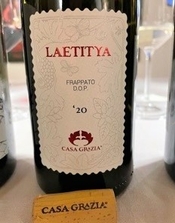 Casa Grazia (Sicilia DOP) “Laetitya” Frappato ($12): This is a red wine that will surely convert white wine drinkers to the dark side, while also pleasing fans of top quality reds. A vibrant nose of rose petals and strawberry rhubarb pie translate directly to palate flavors where bright pepper character offers a savory contrast. It’s long, inviting, and at a price point that everyone will appreciate. 92
Casa Grazia (Sicilia DOP) “Laetitya” Frappato ($12): This is a red wine that will surely convert white wine drinkers to the dark side, while also pleasing fans of top quality reds. A vibrant nose of rose petals and strawberry rhubarb pie translate directly to palate flavors where bright pepper character offers a savory contrast. It’s long, inviting, and at a price point that everyone will appreciate. 92
